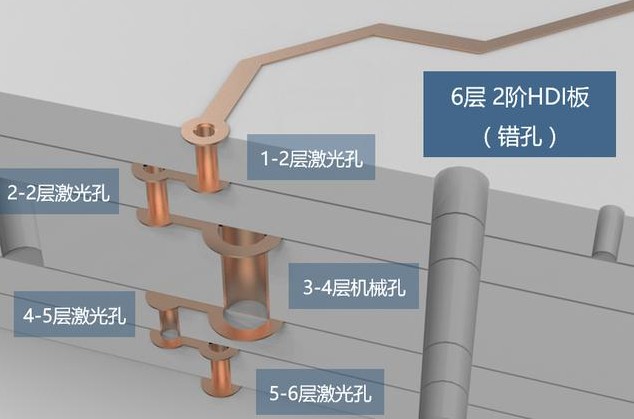HDI PCB layout can be very cramped, but the right set of design rules will help you PCB design successfully.
More advanced PCBs pack more functions in a smaller space, usually using customized IC/SoC, higher layers and smaller traces. To set up the layout of these designs correctly, a set of powerful rule-driven design tools is needed, which can check the wiring and layout according to the design rules when creating the PCB. If you are using the first HDI layout, it may be difficult to see which design rules need to be set when starting the PCB layout.
Set HDI PCB layout
For HDI PCBs, apart from component and wiring density, almost nothing can distinguish these products from standard PCBs. I have seen designers point out that HDI boards refer to anything with 10 million or smaller vias, 6 million or smaller traces, or with 0.5 mm or smaller pin pitch. Your manufacturer will tell you that HDI PCB uses blind holes about 8 mils or smaller, and the smaller blind holes are laser drilled.
In some respects, they are all correct, because there is no specific threshold for the composition of the HDI PCB layout. Everyone can agree that once the design includes microwells, it is an HDI board. In terms of design, you need to set certain design rules before you can touch the layout. Before establishing design rules, you should collect the capabilities of the manufacturer. After this is done, you need to set up design rules and some layout features
Trace width and via size. The width of a trace and its impedance and trace width will determine when you enter the HDI system. Once the trace width becomes small enough, the via will also become so small that it must be manufactured as a micro via.
Layer transition. The through hole needs to be carefully designed according to the aspect ratio, which also depends on the required layer thickness. Layer transitions should be defined early so that they can be placed quickly during the routing process.
gap. The traces must be separated from each other and kept separate from other objects (pads, components, planes, etc.) that are not part of the network. The goal here is to ensure compliance with HDI DFM rules and prevent excessive crosstalk.
Other trace restrictions, such as trace length adjustment, maximum trace length, and allowable impedance deviation during routing are also important, but they will apply to places other than HDI PCB boards. Here, the two most important points are the via size and trace width. The gap can be determined in a variety of ways (for example, simulation) or following standard rules of thumb. Be careful with the latter, as this may result in excessive internal layer crosstalk or insufficient wiring density.
Laminates and vias
The range of HDI stack can vary from a few layers to dozens of layers to adapt to the required routing density. A circuit board with a high pin count and fine pitch BGA can have hundreds of connections per quadrant, so vias need to be set when creating a layer stack for the HDI PCB layout.
If you look at the layer stack manager in the PCB design software, you may not be able to clearly define a specific layer transition as a microvia. It doesn't matter; you can still set the layer transition and then set the via size limit in the design rules.

Once you set the setup rules and create a template, this feature of calling microchannels micropores is very useful. To set a design rule for routing through vias, you can define the design rule to apply only to microvias. This allows you to set specific limits for the gap through the pad size and hole diameter.
Before starting to set up design rules, the manufacturer should be consulted about its functions. Then you need to set the trace width in the design rules to ensure that the trace impedance is controlled at the desired value. In other cases, impedance control is not required, and you may still want to limit the trace width on the HDI board to maintain a higher wiring density.
Trace width
You can determine the required trace width in several ways. First, for impedance-controlled routing, you need one of the following tools:
Calculate the required trace size with pen and paper (difficult way)
Online calculator (quick method)
On-site solver integrated into your design and layout tools (the most accurate method)
The disadvantages of the trace calculator for trace impedance calculation, and the same point of view applies when adjusting trace size for HDI PCB layout.
To set the width of the trace, you can define it as a constraint in the design rule editor, just like using the via size. If you don't worry about impedance control, you can set any width. Otherwise, you need to determine the impedance curve of the PCB stackup and enter this specific width as a design rule.
Since the trace width cannot be too large for the size of the via pad, you need to take a careful balance operation. If the trace width for impedance control is too large, the thickness of the laminate should be reduced, as this will force the trace width to decrease, or the pad size can be increased. As long as the size of the platform exceeds the value listed in the IPC standard, it is fine from a reliability point of view.
gap
HDI PCB layout After completing the two key tasks shown above, you need to determine the appropriate trace gap. Unfortunately, the spacing between traces should not default to 3W or 3H rules of thumb, because these rules are incorrectly applied to advanced boards with high-speed signals. Instead, it is best to perform crosstalk simulations on the proposed trace width and check whether excessive crosstalk will occur.